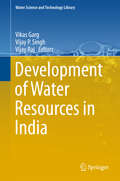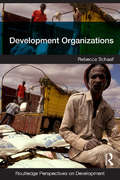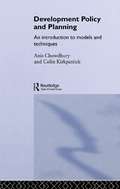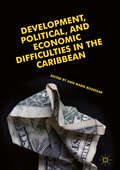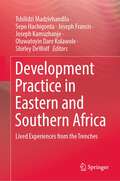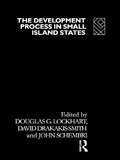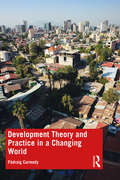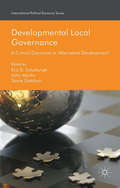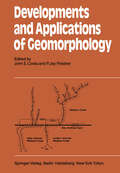- Table View
- List View
The Development of the Action Principle: A Didactic History from Euler-Lagrange to Schwinger (SpringerBriefs in Physics)
by Walter DittrichThis book describes the historical development of the principle of stationary action from the 17th to the 20th centuries. Reference is made to the most important contributors to this topic, in particular Bernoullis, Leibniz, Euler, Lagrange and Laplace. The leading theme is how the action principle is applied to problems in classical physics such as hydrodynamics, electrodynamics and gravity, extending also to the modern formulation of quantum mechanics and quantum field theory, especially quantum electrodynamics. A critical analysis of operator versus c-number field theory is given. The book contains many worked examples. In particular, the term "vacuum" is scrutinized.The book is aimed primarily at actively working researchers, graduate students and historians interested in the philosophical interpretation and evolution of physics; in particular, in understanding the action principle and its application to a wide range of natural phenomena.
A Development of the Equations of Electromagnetism in Material Continua (Springer Tracts in Natural Philosophy #36)
by Harry F. TierstenThis tract is based on lecture notes for a course in mechanics that has been offered at Rensselaer Polytechnic Institute on and off for the past twenty years. The course is intended to provide graduate students in mechanics with an understanding of electromagnetism and prepare them for studies on the interaction of the electric and magnetic fields with deformable solid continua. As such, it is imperative that the distinction between particle and continuum descriptions of matter be carefully made and that the distinction between that which is inherently linear and that which is intrinsically nonlinear be clearly delineated. Every possible effort has been made on my part to achieve these ends. I wish to acknowledge the contributions of a number of students and faculty who attended the lectures over the years and who, by their questions and suggestions, significantly improved some of the sections. This preface would not be complete if I did not point out that my interest in electromagnetism was initiated and my attitude towards the development of the equations was influenced by lectures given by the late Professor R.D. Mindlin at Columbia University in the late nineteen fifties. I would like to thank Professor C. Truesdell for his helpful suggestions, which I feel significantly improved the clarity and readability of the Introduction, and Dr. M.G. Ancona for his comment concerning the clarity of an important point in Sec. 1.1.
Development of Water Resources in India (Water Science and Technology Library #75)
by Vikas Garg Vijay P. Singh Vijay RajThis proceedings volume, with more than 30 chapters, is based on the presentations given at the National Conference on Water Resources and Hydropower (WRHP-2016) and represents the state-of-the-art in water resources in India. It includes experimental investigations, field studies, theoretical developments, numerical methods, as well as engineering achievements in water resources. The contributions are organised under four main topics: • Water Resources and Management: covers the issues related to water resources planning and management, water conservation, flood mitigation, policies and governance, conflict over rivers and planning of groundwater evolution, Assessment of Sedimentation, Surface water quality, Rainfall assessment, • Climate Change and Global Warming: includes chapters on the impact of climate on water resources and groundwater, hydrological impacts of climate change, Ground Water Contaminants, Assessment of Evaporation and evapotranspiration effects on global warming• Hydraulic Structures: presents contributions on fluvial hydraulics,flow through Weirs, Open Channel flow, river flood control, scour and erosion, dam and dowstream block failures and protection, Losses in pipes By combining these topics, the book provides a valuable resource for practitioners and researchers, including field engineers, academicians, planners, health specialists, disaster managers, decision makers and policy makers engaged in various aspects of water resources and hydropower. The WRHP-2016 was organised in association with the Indian Institute of Technology, Roorkee, Uttrakhand Jal Vidyut Nigam Limited and the Indian Society for Hydraulics, Pune and was held in University of Petroleum and Energy Studies, Dehradun, India from June 17-18, 2016.
Development Organizations
by Rebecca SchaafContinuing debates over the meaning of development and awareness of the persistence of poverty have resulted in increasing concern over how to ‘do’ development. There are growing numbers of development organizations, undertaking different activities, at different scales, with different motivations, and differing levels of success. It is necessary to identify and evaluate these varied organizations, in order to recognize their successes and failures. Development Organizations is the first introductory text to focus specifically on the variety of organizations involved in development policy and practice. It explores the range and role of organizations, including community-based organizations and civil society actors, international non-governmental organizations, state and other national-based actors, global forms of governance, international financial institutions and transnational corporations. The historical and contemporary role of each of these actors is considered, with analysis of complex theoretical debates surrounding their existence and their activities. The book also explores the political and contested nature of development activities promoted by these organizations, and their effects on society, the economy and the environment. These issues are also considered in context of the Millennium Development Goals; the agenda which currently impacts on the operation and outcomes of the broad range of development organizations. This invaluable text is richly complimented throughout with case studies to help illustrate the operations of development organizations; from the impact of multinational oil companies in the Niger delta to the impact of IMF reforms in Latin America and the Caribbean. This clearly written and user friendly text contains a wealth of features to assist student learning, including start of chapter learning outcomes, and end of chapter summaries, discussion topics, and suggestions for further reading and relevant websites.
Development Organizations
by Rebecca SchaafContinuing debates over the meaning of development and awareness of the persistence of poverty have resulted in increasing concern over how to ‘do’ development. There are growing numbers of development organizations, undertaking different activities, at different scales, with different motivations, and differing levels of success. It is necessary to identify and evaluate these varied organizations, in order to recognize their successes and failures. Development Organizations is the first introductory text to focus specifically on the variety of organizations involved in development policy and practice. It explores the range and role of organizations, including community-based organizations and civil society actors, international non-governmental organizations, state and other national-based actors, global forms of governance, international financial institutions and transnational corporations. The historical and contemporary role of each of these actors is considered, with analysis of complex theoretical debates surrounding their existence and their activities. The book also explores the political and contested nature of development activities promoted by these organizations, and their effects on society, the economy and the environment. These issues are also considered in context of the Millennium Development Goals; the agenda which currently impacts on the operation and outcomes of the broad range of development organizations. This invaluable text is richly complimented throughout with case studies to help illustrate the operations of development organizations; from the impact of multinational oil companies in the Niger delta to the impact of IMF reforms in Latin America and the Caribbean. This clearly written and user friendly text contains a wealth of features to assist student learning, including start of chapter learning outcomes, and end of chapter summaries, discussion topics, and suggestions for further reading and relevant websites.
Development Policy and Planning: An Introduction to Models and Techniques
by Anis Chowdhury Colin KirkpatrickReorientation from economic controls to a market-based approach led to significant changes in the economic policy of developing countries in the 1980s. Yet, with governments continuing to exercise economic management to accelerate growth beyond that achieved by market forces, techniques and models of development planning are still an integral feature of development policy management. Development Policy and Planning provides a non-technical explanation of the main techniques and models used for economic policy formulation. Each technique is illustrated in application through practical examples.
Development Policy and Planning: An Introduction to Models and Techniques
by Anis Chowdhury Colin KirkpatrickReorientation from economic controls to a market-based approach led to significant changes in the economic policy of developing countries in the 1980s. Yet, with governments continuing to exercise economic management to accelerate growth beyond that achieved by market forces, techniques and models of development planning are still an integral feature of development policy management. Development Policy and Planning provides a non-technical explanation of the main techniques and models used for economic policy formulation. Each technique is illustrated in application through practical examples.
Development, Political, and Economic Difficulties in the Caribbean
by Ann Marie BissessarThis edited volume focuses on the attempts of various Caribbean countries to diversify their economies and societies. It is done in the context of political and economic difficulties that these countries have faced since the 2007-2008 economic crash and how successful they have been in moving their economies in a different direction. The contributors use very distinct levels of analysis in order to provide a nuanced view of diversification efforts in Trinidad and Tobago, Jamaica, Cuba, the French Antilles, and the Dutch Antilles. The book will appeal to academic researchers, practitioners, policy makers, and everyone who is interested in the politics and development of the Caribbean region.
Development Practice in Eastern and Southern Africa: Lived Experiences from the Trenches
by Tshilidzi Madzivhandila Sepo Hachigonta Joseph Francis Joseph Kamuzhanje Oluwatoyin Dare Kolawole Shirley DeWolfThis book is a rare collection of reflective and reflexive stories that reveal how seasoned academics, agents of grassroots social change, leaders and journalists transformed and shaped the development landscape in eastern and southern Africa. Whereas practical experiences are crucial assets and resources for shaping the academic environment and development practice landscape, most of the existing literature recommended as key learning materials in tertiary institutions is rarely in synch with the practical realities of development practice. The shared individual lived experiences from academic endeavours and fieldwork provide hands-on tools for students and emerging practitioners who might be involved in or are currently facilitating development work. The thrust of the book, therefore, is to demystify the day-to-day experiences of development practitioners while contributing to learning pathways or strategies for achieving viable solutions to the myriad of challenges, which grassroots communities face. The relevance of the book as a crucial resource for students pursuing development-oriented degree programmes in colleges and universities is obvious. Without any doubt, the compilation will be handy in the implementation of diverse development-oriented transformation agenda at academic, programming and policy levels.
The Development Process in Small Island States
by Douglas G. Lockhart David Drakakis-Smith John SchembriFirst Published in 2004. Routledge is an imprint of Taylor & Francis, an informa company.
The Development Process in Small Island States
by Douglas G. Lockhart Patrick J. Schembri David W. SmithFirst Published in 2004. Routledge is an imprint of Taylor & Francis, an informa company.
Development Theory and Practice in a Changing World
by Pádraig CarmodyTaking a critical and historical view, this text explores the theory and changing practice of international development. It provides an overview of how the field has evolved and the concrete impacts of this on the ground on the lives of people in the Global South. Development Theory and Practice in a Changing World covers the major theories of development, such as modernisation and dependency, in addition to anti-development theories such as post-modernism and decoloniality. It examines the changing nature of immanent (structural) conditions of development in addition to the main attempts to steer them (imminent development). The book suggests that the era of development as a hegemonic idea and practice may be coming to an end, at the same time as it appears to have achieved its apogee in the Sustainable Development Goals as a result of the rise of ultra-nationalism around the world, the increasing importance of securitisation and the existential threat posed by climate change. Whether development can or should survive as a concept is interrogated in the book. This book offers a fresh and updated take on the past 60 years of development and is essential reading for advanced undergraduate students in areas of development, geography, international studies, political science, economics and sociology.
Development Theory and Practice in a Changing World
by Pádraig CarmodyTaking a critical and historical view, this text explores the theory and changing practice of international development. It provides an overview of how the field has evolved and the concrete impacts of this on the ground on the lives of people in the Global South. Development Theory and Practice in a Changing World covers the major theories of development, such as modernisation and dependency, in addition to anti-development theories such as post-modernism and decoloniality. It examines the changing nature of immanent (structural) conditions of development in addition to the main attempts to steer them (imminent development). The book suggests that the era of development as a hegemonic idea and practice may be coming to an end, at the same time as it appears to have achieved its apogee in the Sustainable Development Goals as a result of the rise of ultra-nationalism around the world, the increasing importance of securitisation and the existential threat posed by climate change. Whether development can or should survive as a concept is interrogated in the book. This book offers a fresh and updated take on the past 60 years of development and is essential reading for advanced undergraduate students in areas of development, geography, international studies, political science, economics and sociology.
Development Tourism: Lessons from Cuba (New Directions in Tourism Analysis)
by Rochelle SpencerTourism in Cuba - described by Fidel Castro as 'the evil we have to have' - has been regarded both with ambivalence, and as a crucial aspect of development and poverty alleviation. The result is a remarkable approach to tourism, one which often compels tourists to become agents of development through solidarity. Drawing on her experiences of working in an NGO in Cuba, the author uses a multi-sited ethnographic approach to investigate tourism motivations and experiences, and to examine the very nature of development. Her analysis covers a wide range of issues including social change, globalization, social theory, and sustainability. Also discussed is the way in which tourism in Cuba relates to broader debates surrounding transformation, capacity building, social action and solidarity.
Development Tourism: Lessons from Cuba (New Directions in Tourism Analysis)
by Rochelle SpencerTourism in Cuba - described by Fidel Castro as 'the evil we have to have' - has been regarded both with ambivalence, and as a crucial aspect of development and poverty alleviation. The result is a remarkable approach to tourism, one which often compels tourists to become agents of development through solidarity. Drawing on her experiences of working in an NGO in Cuba, the author uses a multi-sited ethnographic approach to investigate tourism motivations and experiences, and to examine the very nature of development. Her analysis covers a wide range of issues including social change, globalization, social theory, and sustainability. Also discussed is the way in which tourism in Cuba relates to broader debates surrounding transformation, capacity building, social action and solidarity.
Developmental Environmentalism: State Ambition and Creative Destruction in East Asia’s Green Energy Transition
by Elizabeth Thurbon Hao Tan Sung-Young Kim John A MathewsWhy has East Asia emerged as the global leader in green energy industries but - until recently - lagged on carbon emission reduction? What is new and distinctive about East Asia's approach to the green energy transition? And what does this approach mean for the world? Developmental Environmentalism provides the first comprehensive account of East Asia's green energy shift. It highlights the powerful and symbiotic role of state ambition, geostrategic competition, and capitalist market dynamics in driving forward the region's greening efforts. Through an analysis of the ambitious national strategies of China and South Korea, the authors show how state actors have pursued a distinctively East Asian approach to transforming their energy systems, involving first the rapid creation of new green energy industries and then the coordinated destruction of fossil-fuel incumbencies. This approach - described as 'Developmental Environmentalism' - is aimed at establishing East Asian economies as leaders in the green industries of the future, while at the same time addressing the pressing environmental, social and political problems associated with the carbon-intensive industries of the past. By developing four detailed, longitudinal case studies of green industry creation and fossil-fuel phase out in China and Korea, the authors identify the key successes and failures of East Asia's green shift to date and anticipate its most likely future trajectory. Based on their findings, the authors reject the idea that East Asia's greening strategies are mere exercises in 'greenwashing' or fossil-fuelled 'business as usual'. Rather, there is something fundamentally transformative underway in the region at the level of elite ideation, strategic ambition, and policy action; the green energy shift represents much more than continuity in Asia's erstwhile developmental states. To execute their analysis, the authors synthesise insights from cutting-edge Developmental State and Schumpeterian theorising. They show how state actors in East Asia are engaging in a sophisticated kind of economic statecraft, strategically harnessing the capitalist market dynamics of 'creative-destruction' to advance their transformative green ambitions through green growth. They also assess the implications of developmental environmentalism for developed and developing countries, and the future of the global green shift in an era of geostrategic rivalry.
Developmental Environmentalism: State Ambition and Creative Destruction in East Asia’s Green Energy Transition
by Elizabeth Thurbon Hao Tan Sung-Young Kim John A MathewsWhy has East Asia emerged as the global leader in green energy industries but - until recently - lagged on carbon emission reduction? What is new and distinctive about East Asia's approach to the green energy transition? And what does this approach mean for the world? Developmental Environmentalism provides the first comprehensive account of East Asia's green energy shift. It highlights the powerful and symbiotic role of state ambition, geostrategic competition, and capitalist market dynamics in driving forward the region's greening efforts. Through an analysis of the ambitious national strategies of China and South Korea, the authors show how state actors have pursued a distinctively East Asian approach to transforming their energy systems, involving first the rapid creation of new green energy industries and then the coordinated destruction of fossil-fuel incumbencies. This approach - described as 'Developmental Environmentalism' - is aimed at establishing East Asian economies as leaders in the green industries of the future, while at the same time addressing the pressing environmental, social and political problems associated with the carbon-intensive industries of the past. By developing four detailed, longitudinal case studies of green industry creation and fossil-fuel phase out in China and Korea, the authors identify the key successes and failures of East Asia's green shift to date and anticipate its most likely future trajectory. Based on their findings, the authors reject the idea that East Asia's greening strategies are mere exercises in 'greenwashing' or fossil-fuelled 'business as usual'. Rather, there is something fundamentally transformative underway in the region at the level of elite ideation, strategic ambition, and policy action; the green energy shift represents much more than continuity in Asia's erstwhile developmental states. To execute their analysis, the authors synthesise insights from cutting-edge Developmental State and Schumpeterian theorising. They show how state actors in East Asia are engaging in a sophisticated kind of economic statecraft, strategically harnessing the capitalist market dynamics of 'creative-destruction' to advance their transformative green ambitions through green growth. They also assess the implications of developmental environmentalism for developed and developing countries, and the future of the global green shift in an era of geostrategic rivalry.
Developmental Local Governance: A Critical Discourse in ‘Alternative Development’ (International Political Economy Series)
by John Martin Eris D. Schoburgh Sonia GatchairThe primary purpose of this edited collection is to evaluate critically the relationship between local government and national economic development. It focuses on how the relationship between local government and development is structured, and the specific institutional arrangements at national and subnational levels that might facilitate local government's assumption of the role of development agent. In light of the contradictory outcomes of development and implied experimentation with new modalities, post-development discourse provides a useful explanatory framework for the book. Schoburgh, Martin and Gatchair's central argument is that the pursuit of national developmental goals is given a sustainable foundation when development planning and strategies take into account elements that have the potential to determine the rate of social transformation. Their emphasis on localism establishes a clear link between local government and local economic development in the context of developing countries.
Developments and Applications of Geomorphology
by John E. Costa and P. Jay FleisherThe last decade has seen a remarkable increase in the application of geomorphology for numerous projects and investigations. Geomor phology is now viewed as an indispensable partner of engineering and geology in the world of applied science. For a discipline with few independent theories of its own, geomorphology has become a cosmopolitan science, drawing on many topics from allied sciences. To compile a list of successful and viable applications and contribu tions would be an arduous chore, if not an impossible task. Instead we have compiled a set of invited papers that represent some of the practical developments and uses of geomorphology over the past de cade. Such a compilation of papers will reflect our own back grounds, biases, associations, and personal and professional expe riences. We make no apologies for the topics omitted, but recognize that this volume could be prohibitively large if all the subdivisions of geomorphology were equally and fully covered. Our goal in assembling the papers for this volume was to empha size the concepts, principles, and applications of geomorphology. While techniques, procedures and practical applications are stressed, the reason for each investigation is as important as the method em ployed. This book, therefore, represents the methods used and reasons for applying geomorphology. Where case studies are used, they serve as examples that can be applied in related situations, similar settings and other locations. The authors have successfully addressed this goal in a broad selection of chapter topics.
Developments and Retrospectives in Lie Theory: Geometric and Analytic Methods (Developments in Mathematics #37)
by Geoffrey Mason Ivan Penkov Joseph A. WolfThe Lie Theory Workshop, founded by Joe Wolf (UC, Berkeley), has been running for over two decades. At the beginning, the top universities in California and Utah hosted the meetings, which continue to run on a quarterly basis. Experts in representation theory/Lie theory from various parts of the US, Europe, Asia (China, Japan, Singapore, Russia), Canada, and South and Central America were routinely invited to give talks at these meetings. Nowadays, the workshops are also hosted at universities in Louisiana, Virginia, and Oklahoma. These Lie theory workshops have been sponsored by the NSF, noting the talks have been seminal in describing new perspectives in the field covering broad areas of current research. The contributors have all participated in these Lie theory workshops and include in this volume expository articles which will cover representation theory from the algebraic, geometric, analytic, and topological perspectives with also important connections to math physics. These survey articles, review and update the prominent seminal series of workshops in representation/Lie theory mentioned above, and reflects the widespread influence of those workshops in such areas as harmonic analysis, representation theory, differential geometry, algebraic geometry, number theory, and mathematical physics. Many of the contributors have had prominent roles in both the classical and modern developments of Lie theory and its applications.
Developments in 3D Geo-Information Sciences (Lecture Notes in Geoinformation and Cartography)
by Tijs Neutens Philippe De MaeyerRealistically representing our three-dimensional world has been the subject of many (philosophical) discussions since ancient times. While the recognition of the globular shape of the Earth goes back to Pythagoras’ statements of the sixth century B. C. , the two-dimensional, circular depiction of the Earth’s surface has remained prevailing and also dominated the art of painting until the late Middle Ages. Given the immature technological means, objects on the Earth’s surface were often represented in academic and technical disciplines by two-dimensional cross-sections oriented along combinations of three mutually perpendicular directions. As soon as computer science evolved, scientists have steadily been improving the three-dimensional representation of the Earth and developed techniques to analyze the many natural processes and phenomena taking part on its surface. Both computer aided design (CAD) and geographical information systems (GIS) have been developed in parallel during the last three decades. While the former concentrates more on the detailed design of geometric models of object shapes, the latter emphasizes the topological relationships between geographical objects and analysis of spatial patterns. Nonetheless, this distinction has become increasingly blurred and both approaches have been integrated into commercial software packages. In recent years, an active line of inquiry has emerged along the junctures of CAD and GIS, viz. 3D geoinformation science. Studies along this line have recently made significant inroads in terms of 3D modeling and data acquisition.
Developments in Astrometry and Their Impact on Astrophysics and Geodynamics: Proceedings of the 156th Symposium of the International Astronomical Union Held in Shanghai, China, September 15–19, 1992 (International Astronomical Union Symposia #156)
by Ivan I. Mueller Barbara KolaczekIn this review talk, I would like to report on the proper motion analysis, which has been recently carried out together with M. Soma and M. Yoshizawa: There has been a persistent demand in astronomy for accurate stellar positions and proper motions, which are represented by an inertial reference system constructed on the basis of a set of consistent astronomical constants. In the reference system the precessional constant plays a primary role. In a series of papers Fricke (1967a,b, 1977a,b) has deter mined the luni-solar precessional correction to Newcomb's value and the fictitious motion of the equinox, which have been adopted in the "IAU (1976) System of Astronomical Con stants". Based on the precessional correction and the equinoctial motion thus established, the fundamental reference system, the FK5 system (Fricke et al. 1988) for positions and proper motions, has been constructed. However, for several years geodetic VLBI (McCarthy & Luzum 1991) and LLR (Williams et at. 1991) observations have been suggesting an additional correction to the luni-solar precessional constant of the IAU (1976) System. That is, these observations indicate the precessional correction of 6. p ~ -0:'30/cent to the FK5 system. But, the observational period ofthe earth orientation is considered to be still insufficient to separate unambiguously the precessional change of the earth orientation from the nutation with the longest period of 18. 6 years.
Developments in Diving Technology: Proceedings of an international conference, (Divetech ’84) organized by the Society for Underwater Technology, and held in London, UK, 14–15 November 1984 (Advances in Underwater Technology, Ocean Science and Offshore Engineering #1)
by Society for Underwater Technology (SUT)Up to about 30 years' ago diving activity was centred primarily on the naval services, who provided a lead in the development of equipment, techniques and procedures. Apart from one or two spectacular salvage undertakings, the main commercial activity up until that time was fairly low-key work in docks and harbours. The concept of saturation diving emerged from subsea habitats of which Captain Cousteau was one of the pioneers. This led the way to commercial development in support of exploration and the production of offshore oil and gas, and I believe that my friend Henri Delauze was one of the first to mount the subsea habitat on deck and provide a sealed bell to convey divers from the habitat to the seabed without change of pressure. A remarkable feature of offshore oil and gas technology in the North Sea has been the willingness of all concerned to exchange information regarding R&D. This has had a major effect on the advance in technology over the last few years. As far as diving is concerned, it is to some extent 'Hobson's Choice'. Legal patents are difficult to achieve in this field, and the casual nature of diver employment to date has meant that ideas and techniques circulate almost as freely as the divers themselves. In addition, the advertis ing of the new technologies which one has to offer almost auto matically means disclosure of what otherwise might be secret.
Developments in Dynamic Soil-Structure Interaction (Nato Science Series C: #390)
by Polat Gülkan Ray W. CloughFor the last couple of decades it has been recognized that the foundation material on which a structure is constructed may interact dynamically with the structure during its response to dynamic excitation to the extent that the stresses and deflections in the system are modified from the values that would have been developed if it had been on a rigid foundation. This phenomenon is examined in detail in the book. The basic solutions are examined in time and frequency domains and finite element and boundary element solutions compared. Experimental investigations aimed at correlation and verification with theory are described in detail. A wide variety of SSI problems may be formulated and solved approximately using simplified models in lieu of rigorous procedures; the book gives a good overview of these methods. A feature which often lacks in other texts on the subject is the way in which dynamic behavior of soil can be modeled. Two contributors have addressed this problem from the computational and physical characterization viewpoints. The book illustrates practical areas with the analysis of tunnel linings and stiffness and damping of pile groups. Finally, design code provisions and derivation of design input motions complete this thorough overview of SSI in conventional engineering practice. Taken in its entirety the book, authored by fifteen well known experts, gives an in-depth review of soil-structure interaction across a broad spectrum of aspects usually not covered in a single volume. It should be a readily useable reference for the research worker as well as the advance level practitioner. (abstract) This book treats the dynamic soil-structure interaction phenomenon across a broad spectrum of aspects ranging from basic theory, simplified and rigorous solution techniques and their comparisons as well as successes in predicting experimentally recorded measurements. Dynamic soil behavior and practical problems are given thorough coverage. It is intended to serve both as a readily understandable reference work for the researcher and the advanced-level practitioner.
Developments in Earthquake Geotechnics (Geotechnical, Geological and Earthquake Engineering #43)
by Susumu IaiThis book provides a timely review and summary of the recent advances in state-of-the-art earthquake geotechnics. The earthquake disasters in Japan and New Zealand in 2011 prompted the urgent need for the state-of-the-art earthquake geotechnics to be put into practice for disaster mitigation. By reviewing the developments in earthquake geotechnics over more than half a century, this unique book enables readers to obtain solid grasp of this discipline. It is based on contributions from 18 leading international experts, who met in Kyoto in June 2016 to discuss a range of issues related to the developments of earthquake geotechnics. It comprehensively discusses various areas of earthquake geotechnics, including performance-based seismic design; the evolution of geotechnical seismic response analysis from 1964-2015; countermeasures against liquefaction; solutions for nuclear power plant disasters; the tsunami-caused inundation of the Tokyo metropolitan area; and a series of state-of-the-art effective stress analyses of case histories from the 2011 East Japan Earthquake. The book is of interest to advanced level researchers and practicing engineers in the field of earthquake geotechnics.


